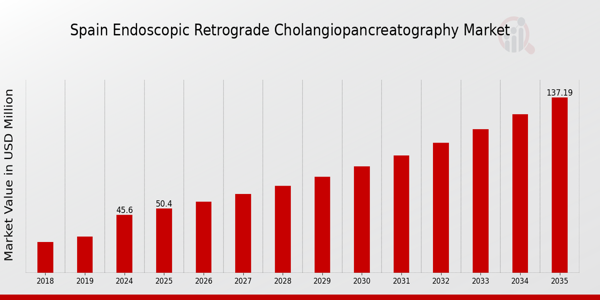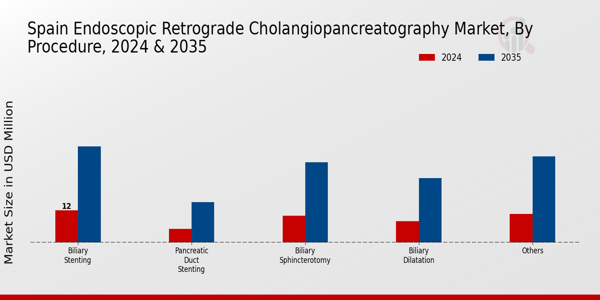Spain Endoscopic Retrograde Cholangiopancreatography Market Overview
As per MRFR analysis, the Spain Endoscopic Retrograde Cholangiopancreatography Market Size was estimated at 41.53 (USD Million) in 2023.The Spain Endoscopic Retrograde Cholangiopancreatography Market is expected to grow from 45.6(USD Million) in 2024 to 137.2 (USD Million) by 2035. The Spain Endoscopic Retrograde Cholangiopancreatography Market CAGR (growth rate) is expected to be around 10.532% during the forecast period (2025 - 2035).
Key Spain Endoscopic Retrograde Cholangiopancreatography Market Trends Highlighted
A number of noteworthy factors are influencing the growth of the Endoscopic Retrograde Cholangiopancreatography (ERCP) market in Spain. The growing incidence of pancreatic and biliary illnesses, which has raised demand for minimally invasive procedures, is a major market driver.
Further supporting this trend are developments in ERCP technology, including as improved endoscopic instruments and imaging methods that make operations safer and more efficient for patients. The healthcare industry's emphasis on enhancing patient outcomes and shortening recovery times is also creating opportunities in the Spanish market.
Furthermore, there is a chance for increased accuracy and efficiency when digital platforms and artificial intelligence are incorporated into ERCP processes. More individualised treatment regimens are now possible thanks to the growing use of these cutting-edge solutions by Spanish hospitals and clinics. The importance of education and training for medical personnel engaged in ERCP has increased recently.
Continuous professional growth in endoscopic procedures is being prioritised in Spain's strong healthcare system to guarantee that medical professionals have the newest information and abilities. Additionally, it is anticipated that hospital-technological company collaborations would increase, spurring innovation in ERCP methods and instruments.
Another discernible trend in the Spanish ERCP industry is the move towards outpatient settings for a variety of medical treatments. Outpatient care is becoming more and more popular among patients, which may result in lower medical expenses and more convenience.
All things considered, these patterns show a changing market for endoscopic retrograde cholangiopancreatography in Spain that is centred on raising the standard of service, developing new technologies, and satisfying patients' changing demands.

Source: Primary Research, Secondary Research, Market Research Future Database and Analyst Review
Spain Endoscopic Retrograde Cholangiopancreatography Market Drivers
Increasing Prevalence of Gastrointestinal Disorders
The Spain Endoscopic Retrograde Cholangiopancreatography Market is significantly driven by the rising incidence of gastrointestinal disorders, including pancreatitis and cholangitis.
According to the Spanish Ministry of Health, around 25% of the population in Spain suffers from some form of gastrointestinal issue, which correlates strongly with the need for diagnostic procedures like endoscopic retrograde cholangiopancreatography.
Additionally, a report from the Gastroenterology Association of Spain indicates that there has been a 15% increase in hospitalizations related to gastrointestinal diseases over the past five years.
This trend is expected to boost the demand for endoscopic procedures, showcasing how a larger patient base needing treatment will enhance the Spain Endoscopic Retrograde Cholangiopancreatography Market significantly. Furthermore, advances in endoscopic techniques and technology, as seen with the incorporation of AI diagnostics by leading hospitals in Spain, are reinforcing this growth area.
Technological Advancements in Endoscopic Equipment
Innovative technological advancements within medical instrumentation are a critical driver for the Spain Endoscopic Retrograde Cholangiopancreatography Market. The adaptation of high-definition imaging and the integration of robotics in endoscopy have enhanced the precision and effectiveness of procedures.
A recent report by the Spanish Medical Technology Association indicated that the usage of advanced imaging techniques has improved diagnostic accuracy by up to 30%.
As hospitals and clinics in Spain increasingly invest in cutting-edge equipment, such as those developed by companies like Olympus Corporation and Karl Storz, the efficiency and quality of endoscopic retrograde cholangiopancreatography procedures will likely experience significant enhancements, fostering growth in the overall market.
Growing Awareness and Acceptance of Minimally Invasive Procedures
There is a notable increase in awareness among patients and healthcare providers regarding the benefits of minimally invasive procedures, further propelling the Spain Endoscopic Retrograde Cholangiopancreatography Market.
Many patients prefer these options due to their shorter recovery times and reduced risks compared to traditional surgical methods. According to the Spanish Surgeon General's guidance, nearly 75% of patients expressed a preference for minimally invasive techniques when presented with surgical options.
This growing acceptance not only drives higher patient consultation rates but also sees operators more inclined to recommend endoscopic retrograde cholangiopancreatography as a first-line diagnostic tool, thereby broadening the market scope in Spain.
Spain Endoscopic Retrograde Cholangiopancreatography Market Segment Insights
Endoscopic Retrograde Cholangiopancreatography Market Procedure Insights
The Spain Endoscopic Retrograde Cholangiopancreatography Market, particularly within the Procedure segment, showcases a diverse landscape with various techniques employed to address biliary and pancreatic ductal disorders.
The advent of advanced technologies in endoscopic procedures has significantly improved patient outcomes, making these interventions increasingly adopted by healthcare professionals in Spain.
Biliary Sphincterotomy, for instance, plays a crucial role in facilitating the extraction of stones from the bile duct, thereby relieving obstructive jaundice and associated complications, highlighting its importance in clinical practice.
Meanwhile, Biliary Stenting is gaining traction as a valuable technique for patients with malignant biliary obstruction, as it aids in maintaining biliary patency, emphasizing the need for effective treatment options in managing advanced-stage cancers.
Additionally, Biliary Dilatation serves as an essential procedure for treating strictures and ensuring proper passage of bile, reflecting the ongoing need for innovative therapeutic approaches.
Pancreatic Duct Stenting has also emerged as a significant technique in managing chronic pancreatitis and other ductal disorders, illustrating the critical need for targeted interventions to alleviate symptoms and improve the quality of life for patients.
The diversification of these procedures indicates a dynamic evolution in the Spain Endoscopic Retrograde Cholangiopancreatography Market, fueled by an increasing prevalence of biliary and pancreatic diseases and the growing emphasis on minimally invasive surgical techniques.
As healthcare organizations and practitioners continue to prioritize patient-centric care, the importance of procedural advancements in this market segment will likely rise, presenting opportunities for further research and development in the coming years.

Source: Primary Research, Secondary Research, Market Research Future Database and Analyst Review
Endoscopic Retrograde Cholangiopancreatography Market End-user Insights
The Spain Endoscopic Retrograde Cholangiopancreatography Market, particularly in the End-user segment, showcases a diverse landscape with significant contributions from Hospitals and Clinics as well as Ambulatory Surgical Centers.
Hospitals and Clinics typically hold a major share of the market due to their comprehensive facilities and advanced equipment, enabling highly specialized procedures that are vital for patient care.
These facilities not only benefit from having skilled medical professionals but also leverage the latest technology in gastroenterology, which enhances outcomes for patients undergoing endoscopic procedures.
On the other hand, Ambulatory Surgical Centers are gaining traction, driven by their ability to offer cost-effective, outpatient services that provide convenience and quicker recovery for patients. The rising demand for minimally invasive interventions supports the growth of these centers, as they provide efficient treatment options for conditions necessitating endoscopic retrograde cholangiopancreatography.
Overall, this segmentation reflects a dynamic interplay of traditional hospital settings and modern outpatient facilities, catering to the evolving healthcare needs of the Spanish population.
Endoscopic Retrograde Cholangiopancreatography Market Application Insights
The Spain Endoscopic Retrograde Cholangiopancreatography Market demonstrates a diverse Application segment, prominently featuring areas such as Bile Duct, Pancreas, and Others. The Bile Duct segment is critical due to the rising prevalence of choledocholithiasis and other biliary disorders that demand precise diagnostic and therapeutic endoscopic procedures.
The Pancreas segment showcases its significance through the increasing incidence of pancreatic diseases, which necessitate advanced interventions for accurate diagnostics and treatment. Additionally, the Others category encompasses various applications that augment the versatility of endoscopic techniques, contributing to improved patient outcomes and procedural efficiency.
Trends indicate a growing preference for minimally invasive surgeries, driven by factors such as shorter recovery times and enhanced patient satisfaction. However, challenges like limited awareness and access to specialized procedures in certain regions may hinder growth.
Opportunities lie in technological advancements and strategic collaborations, which could enhance the overall effectiveness and adoption of endoscopic procedures across these key areas in the Spain Endoscopic Retrograde Cholangiopancreatography Market.
Endoscopic Retrograde Cholangiopancreatography Market Product Insights
The Spain Endoscopic Retrograde Cholangiopancreatography Market features a diverse array of products, prominently including Endoscopes, Imaging Devices, and Energy Devices. Endoscopes play a pivotal role in the visualization and intervention procedures, allowing for minimally invasive diagnosis and treatment, making them essential in the healthcare landscape.
Imaging Devices significantly enhance the accuracy and efficiency of procedures, utilizing advanced technology that aids healthcare professionals in making more informed decisions, thereby improving patient outcomes. Energy Devices, crucial for therapeutic interventions, are employed to facilitate various procedures and ensure effective treatment of diseases related to the biliary and pancreatic systems.
The growth in the demand for these products is driven by factors such as an increasing incidence of biliary tract diseases, advancements in healthcare technology, and a growing focus on minimally invasive procedures in Spain.
The market is expected to experience steady progress, driven by an increasing awareness of digestive health and enhanced investment in healthcare infrastructure within the country.
As Spain continues to advance its medical technology frameworks, the role of each product in the Endoscopic Retrograde Cholangiopancreatography Market becomes increasingly significant, reinforcing their importance in the overall healthcare system.
Spain Endoscopic Retrograde Cholangiopancreatography Market Key Players and Competitive Insights
The Spain Endoscopic Retrograde Cholangiopancreatography Market is characterized by a competitive landscape influenced by advancements in technology, patient demographics, and healthcare frameworks. With increasing incidences of biliary and pancreatic disorders, the demand for endoscopic procedures such as ERCP is on the rise, leading to growth opportunities for various players in the market.
Healthcare providers are continuously seeking innovative solutions to enhance procedural efficiency, patient safety, and clinical outcomes. The competitive dynamics within the market are shaped by product offerings, research and development activities, and the strategic initiatives taken by leading companies to strengthen their foothold in the region.
C.R. Bard has managed to establish itself as a strong competitor within the Spain Endoscopic Retrograde Cholangiopancreatography Market through its high-quality endoscopic devices. The company's innovative approach to product development, characterized by a comprehensive array of catheter systems and ancillary tools tailored for ERCP procedures, positions C.R. Bard well within the marketplace.
Its strong distribution network and strategic collaborations with hospitals and healthcare facilities in Spain further enhance its market presence. The company's focus on customer education and training programs promptly addresses any procedural challenges faced by medical professionals, reinforcing its reputation and reliability in the sector.
Moreover, C.R. Bard's commitment to research and development ensures that it continuously introduces advanced solutions in ERCP, keeping pace with the evolving demands of the healthcare environment.
Johnson & Johnson holds a significant share in the Spain Endoscopic Retrograde Cholangiopancreatography Market through its comprehensive product portfolio. The company offers various endoscopic devices, including specialized ERCP tools that contribute to improved procedural efficiency and reduced complication rates.
Johnson & Johnson's robust presence in Spain is bolstered by its extensive distribution channels and partnerships with key healthcare institutions. The company focuses on continual innovation and has launched several key products designed to optimize the endoscopic experience for both physicians and patients.
Furthermore, Johnson & Johnson's strategic mergers and acquisitions have expanded its capabilities and product offerings, ensuring that it remains a pivotal player in this highly competitive market. Its dedication to enhancing patient care aligns with the broader healthcare goals prevalent in Spain, making it a formidable contender in the Endoscopic Retrograde Cholangiopancreatography sector.
Key Companies in the Spain Endoscopic Retrograde Cholangiopancreatography Market Include:
- C.R. Bard
- Johnson & Johnson
- Karl Storz
- B. Braun Melsungen AG
- Boston Scientific
- Olympus Corporation
- Medtronic
- Stryker
- EndoChoice
- Cook Medical
- Terumo Corporation
- Hoya Corporation
- Ambu
- Fujifilm Holdings
- ConMed
Spain Endoscopic Retrograde Cholangiopancreatography Market Developments
The Spain Endoscopic Retrograde Cholangiopancreatography Market has experienced significant developments in recent months. In October 2023, Johnson and Johnson announced advancements in minimally invasive surgical techniques that are set to enhance the efficacy of endoscopic retrograde cholangiopancreatography, specifically targeting gallstone removal and bile duct procedures.
Moreover, in August 2023, C.R. Bard launched a new line of catheters designed to improve patient outcomes during this procedure, reflecting a growing trend toward innovation in medical instruments.
The strategic collaboration between Olympus Corporation and Cook Medical, inked in May 2023, aims to combine technologies for enhanced imaging during procedures, thereby improving diagnostic capabilities in hospitals across Spain.
Additionally, as of September 2023, the Spanish government allocated increased funding for healthcare modernization, focusing on technologies like endoscopic retrograde cholangiopancreatography. This financial boost signals an optimistic growth trajectory, as it aims to expand treatment availability and improve patient care.
Notably, B. Braun Melsungen AG has reported a steady increase in sales, indicating rising demand for their gastroenterological products within the Spanish market over the past two years, supporting wider accessibility to these critical procedures.
Spain Endoscopic Retrograde Cholangiopancreatography Market Segmentation Insights
Endoscopic Retrograde Cholangiopancreatography Market Procedure Outlook
- Biliary Sphincterotomy
- Biliary Stenting
- Biliary Dilatation
- Pancreatic Duct Stenting
- Others
Endoscopic Retrograde Cholangiopancreatography Market End-user Outlook
- Hospitals & Clinics
- Ambulatory Surgical Centers
Endoscopic Retrograde Cholangiopancreatography Market Application Outlook
- Bile Duct
- Pancreas
- Others
Endoscopic Retrograde Cholangiopancreatography Market Product Outlook
- Endoscopes
- Imaging Devices
- Energy Devices
| Report Attribute/Metric Source: |
Details |
| MARKET SIZE 2023 |
41.53(USD Million) |
| MARKET SIZE 2024 |
45.6(USD Million) |
| MARKET SIZE 2035 |
137.2(USD Million) |
| COMPOUND ANNUAL GROWTH RATE (CAGR) |
10.532% (2025 - 2035) |
| REPORT COVERAGE |
Revenue Forecast, Competitive Landscape, Growth Factors, and Trends |
| BASE YEAR |
2024 |
| MARKET FORECAST PERIOD |
2025 - 2035 |
| HISTORICAL DATA |
2019 - 2024 |
| MARKET FORECAST UNITS |
USD Million |
| KEY COMPANIES PROFILED |
C.R. Bard, Johnson & Johnson, Karl Storz, B. Braun Melsungen AG, Boston Scientific, Olympus Corporation, Medtronic, Stryker, EndoChoice, Cook Medical, Terumo Corporation, Hoya Corporation, Ambu, Fujifilm Holdings, ConMed |
| SEGMENTS COVERED |
Procedure, End User, Application, Product |
| KEY MARKET OPPORTUNITIES |
Increasing demand for minimally invasive procedures, Growing elderly population needing treatment, Advancements in endoscopic technologies, Rising prevalence of biliary disorders, Expanding healthcare infrastructure and funding |
| KEY MARKET DYNAMICS |
increasing prevalence of gastrointestinal disorders, advancements in endoscopic technology, growing geriatric population, rising demand for minimally invasive procedures, supportive reimbursement policies |
| COUNTRIES COVERED |
Spain |
Frequently Asked Questions (FAQ):
The Spain Endoscopic Retrograde Cholangiopancreatography Market is expected to be valued at 45.6 million USD in 2024.
By 2035, the Spain Endoscopic Retrograde Cholangiopancreatography Market is projected to reach 137.2 million USD.
The market is expected to grow at a CAGR of 10.532% from 2025 to 2035.
The Biliary Sphincterotomy segment is expected to hold the highest market value at 30.0 million USD in 2035.
Major players in the market include C.R. Bard, Johnson & Johnson, Karl Storz, B. Braun Melsungen AG, Boston Scientific, and Olympus Corporation.
The Biliary Stenting procedure is projected to be valued at 12.0 million USD in 2024.
The Biliary Dilatation segment is expected to grow to 24.0 million USD by 2035.
In 2024, the Pancreatic Duct Stenting procedure is expected to be valued at 5.0 million USD.
The market is expected to see substantial growth driven by advancements in medical technology and increasing healthcare expenditure.
The Others procedure segment is expected to reach 32.2 million USD by 2035.
















